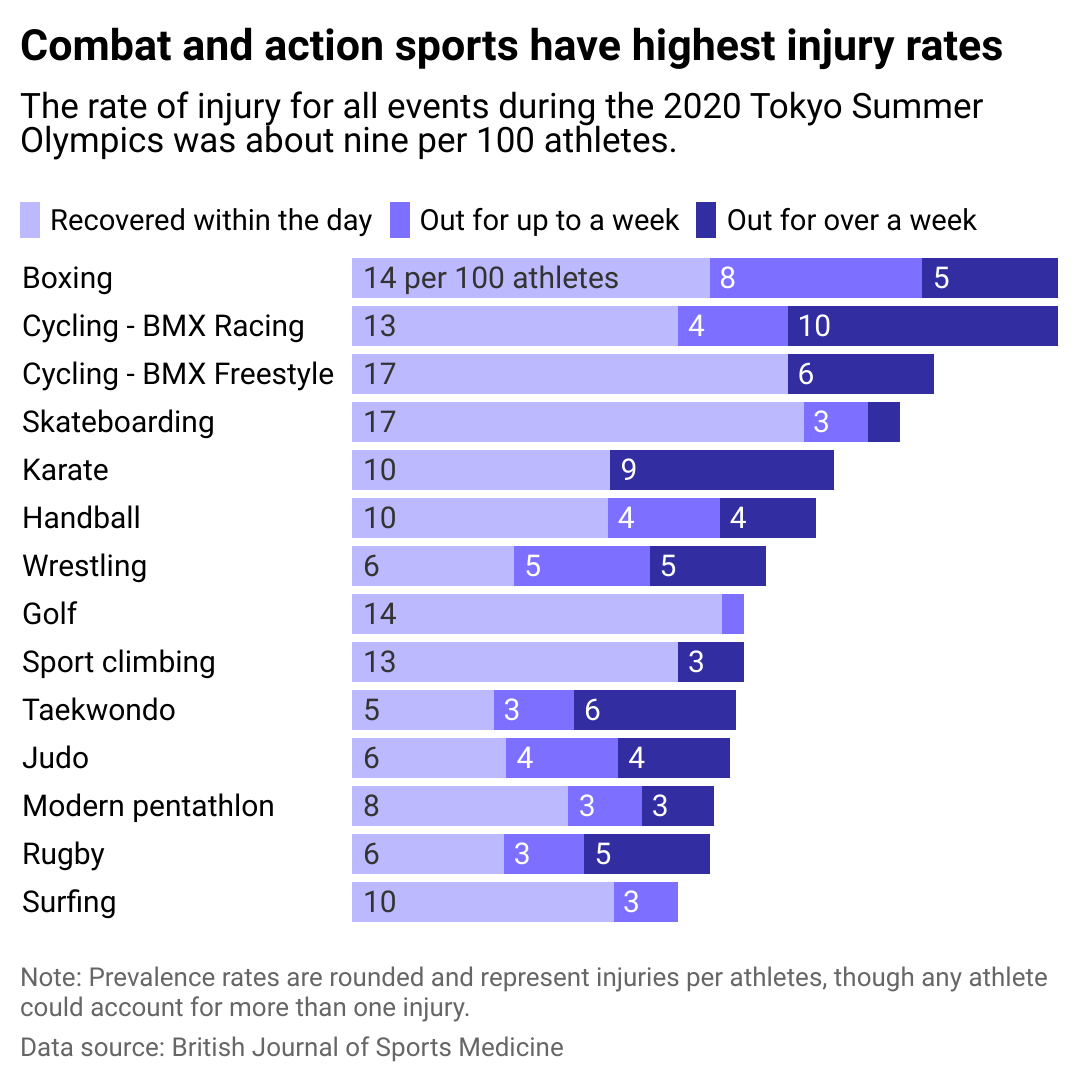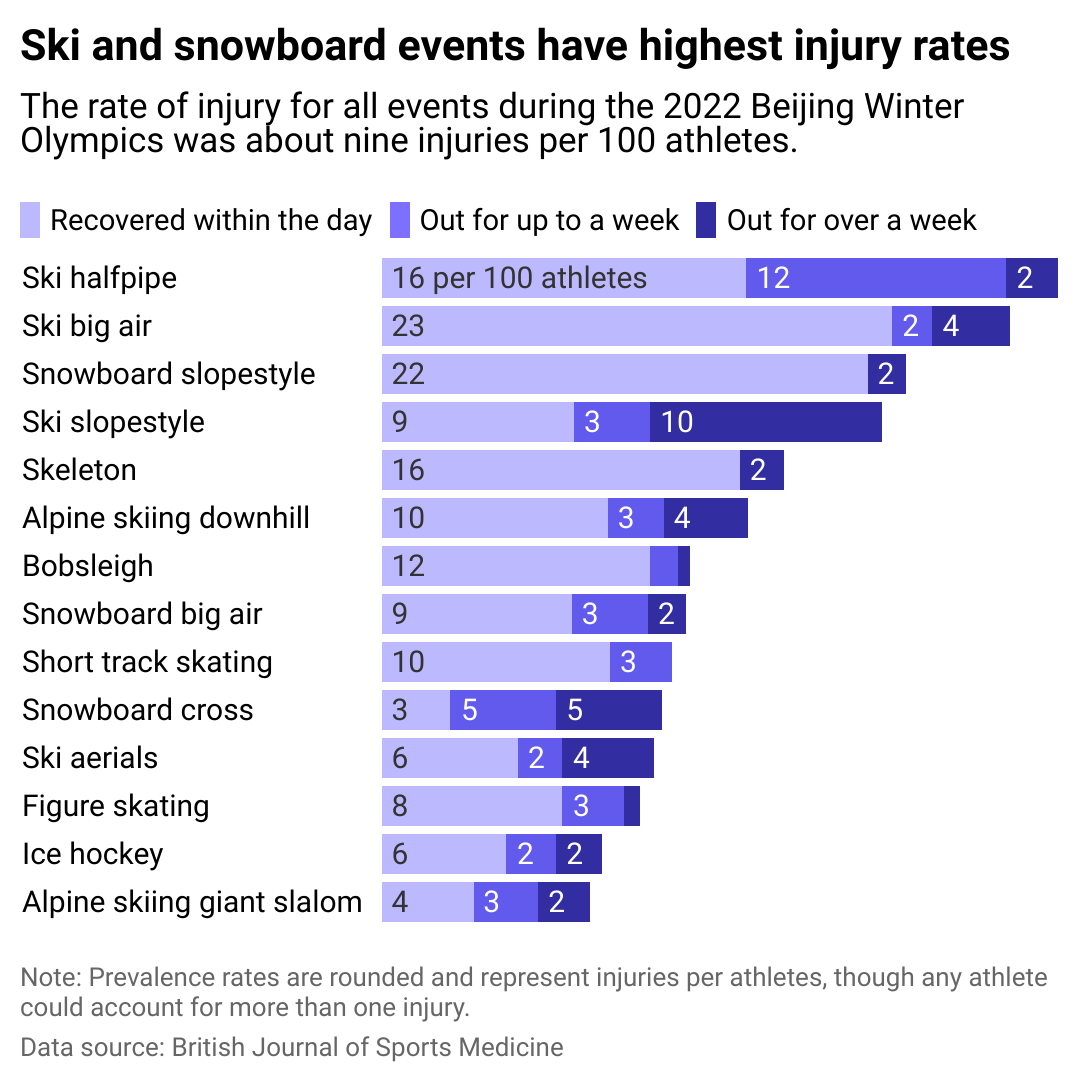Simone Biles' decision to forgo participation in the gymnastics competition during the Tokyo 2020 Summer Olympics because she was experiencing the "twisties" was a wake-up call to many spectators and fans watching the sport. Gymnastics is extremely dangerous, and if Biles had experienced anything off with the coordination of her body and brain, it could have resulted in a catastrophic fall.
"She really could die—that's how serious it is," sports psychologist Carlin Anderson told DW at the time.
Tokyo was Biles' second Olympic Games, so sitting it out didn't impact her overall legacy, but for many athletes, that situation would have been career-ending.
As Paris 2024 approaches, Northwell Health partnered with Stacker to explore the sports with the highest rates of injuries during the Tokyo and Beijing Olympics, using data from two British Journal of Sports Medicine reports. The data only looks at injuries during the Olympics, not sporting events outside of the Games.
The pinnacle of most sports is the Olympics—summer or winter—and athletes work their entire lives to reach that milestone—often only attending a handful of Games since they only happen every four years. If an athlete gets injured while competing at the Games and misses their shot to reach the apotheosis of their sport, it can be devasting.
BMX racer Connor Fields and slopestyle snowboarder Torstein Horgmo sustained life-threatening and season-ending injuries at the Tokyo and Sochi Olympics, respectively, and were unable to compete.
For the more dangerous sports, like BMX racing and alpine skiing, medical staff are positioned on the course and have a few seconds to respond to the injured athlete lest things turn tragic. As viewers tune in to watch the amazing physical feats of athletes in Paris, these numbers are a sobering reminder that the human body can endure much but also has limits.

BMX racing was the most dangerous sport at Tokyo 2020, especially when taking injuries that last longer than a week into account. The sport was officially introduced on the Olympic stage in 2008 and has since been riddled with injuries as bike riders take to the hilly terrain.
During Tokyo 2020, 2016 Olympic gold medalist Connor Fields was in the lead and heading into the semifinal round of the competition when another rider ran into him while he was landing a jump 9 seconds into the race. Fields went headfirst over his handlebars into the ground, sustaining a subarachnoid hemorrhage and subdural hematoma, resulting in blood rushing to the surface of his brain. The athlete also suffered a collapsed lung and broken ribs.
Team USA's doctor for the Games described the injury to The New York Times as "the worst injury of the Tokyo Summer Games."
Another New York Times report described the BMX racing medical setup at Tokyo 2020, which involved five teams of medics at different areas of the track, each with a stretcher and three ambulances behind the main scoreboard.
Boxing is another sport that also has a high rate of concussions or possible death at the Summer Olympics. Given the body blows and shear pounding to the head absorbed by athletes to put up a winning score, it is no shock that concussions are extremely common—even outside Olympic competitions.
Until 2016, male boxers were required to wear headgear. However, in 2013, the International Boxing Association decided to remove the headgear for male boxers in international tournaments because it found that the protection wasn't preventing concussions and other brain injuries.
It's not clear if the removal of the headgear has led to more or fewer head injuries.
"It is difficult to say which preventative effects are due to using headguards and which are due to other changes, such as, for example, rule modifications or improved education programs for coaches, fight doctors and boxing officials," researchers wrote in a European Journal Of Sport Science report published in 2021.

Ski and snowboard slopestyle are two of the Beijing 2022 Winter Olympics' most dangerous and injury-riddled sports—especially long-term injuries, in the case of ski slopestyle. The hilly, rugged, icy terrain athletes rely on for both sports to jump and perform acrobatics routinely puts athletes at risk of breaking anything.
Just after the slopestyle events were brought to the Olympic arena at Sochi 2014, numerous athlete headliners like Shaun White and Torstein Horgmo pulled out either due to or the fear of injury. In the case of Norwegian Horgmo, he broke his collarbone in a training accident in Sochi just as the Games were beginning.
"It's like jumping out of a building," Canadian snowboarder Sébastien Toutant described the course to the Olympic News Service at the time.
Alpine skiing is another Winter Olympic sport that is extremely grueling on athletes and can be catastrophic, given skiers' rate of speed downhill. During competition, skiers can reach speeds of 90 miles per hour or more. Dr. Che Lu, one of 37 ski doctors who worked Beijing 2022, told China Daily that time is everything when rescuing an injured athlete.
She prepares a 33-pound trauma bag carrying lifesaving equipment like an air mask, airway support equipment, splints, and an oxygen tank. To reach the athlete, doctors must wade through sharp, icy, rugged terrain in subzero temperatures to perform what is needed. If it is something more severe, a toboggan or helicopter has to transport the racer to the hospital.
"All these movements are ideally to be finished within 15 minutes," Lu told China Daily.
Story editing by Carren Jao. Copy editing by Paris Close. Photo selection by Clarese Moller.
This story originally appeared on Northwell Health and was produced and distributed in partnership with Stacker Studio.